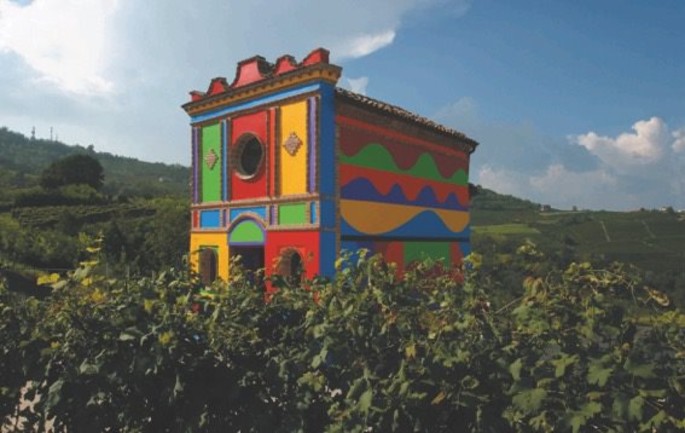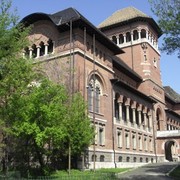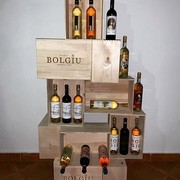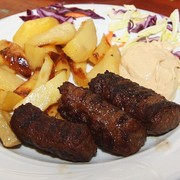The Langhe is a small strip of land extending to the south of the Piedmont region. Its cultural pole is the village of Barolo, where the “king of wines” has its origins. The hills of the landscape follow each other in gentle slopes and are cultivated with vineyards, which create intricate geometric designs. The region was created by the immersion of the Padano Sea during the Langhiana Tertiary period, but the origins of the name are uncertain: the term Langa may derive from “landa”, uncultivated land, or possibly from “languae”, tongue of land.
On the peaks of the Langhe hills stand numerous castles and medieval fortresses, among them the castles of Serralunga, Barolo residence to the Falletti since 1325, Roddi, Castiglione Falletto, and Grinzane Cavour, once home to the statesman and wine producer Camillo Benso, Count of Cavour.
Here on these lands they produce the Barolo wine, one of the best in the world. A long lived wine, with excellent structure, it pairs well with main courses of red meat and cheeses. It’s made from the Nebbiolo vine species, which is cultivated in a limited zone comprising the towns of 11 villages. Other wines like Nebbiolo, Barbera d’Alba and Dolcetto d’Alba. Completing the range of reds are the dry sparkling Langhe Freisa, and the Verduno Pelavergaand for white wines the Langhe Chardonnay stands out.
The Langhe Region also boasts an important gastronomic tradition. It has roots in both the peasant and bourgeoisie ways of life. The meeting of these two worlds has led to the excellent cuisine that we know today. The ingredients for typical Langhe dishes come mostly from the hills and surrounding lands, nevertheless ingredients coming from the Aosta Valley and Liguria also have great importance. At one time wine was traded with these regions in exchange for oil, salt, anchovies and Fontina cheese. Thanks to this geographic blending the great traditional recipes were created, including Bagna caoda, made from a base of garlic and anchovies and Fondue made with Fontina cheese from the Aosta Valley.
Another product of excellence is the white truffle of Alba (capital of the Langhe).
Other excellent traditional dishes range from hors d’oeuvre to deserts, offering many delicacies beside those already mentioned, like veal with tuna sauce, tongue with sauce, anchovies al verde, stewed tripe, agnolotti del plin (pasta named for the way they are closed with a pinch), mixed boiled meat with sauce, braised meat al Barolo, stuffing à la financière, the mixed fry, wild hare in civet, jugged pheasant and to finish, delicious desserts: hazelnut cake, stuffed peaches, bonet, cooked cream, and timballo of Martine pears. At the conclusion of a delicious meal, a glass of Barolo Chinato is suggested, an aromatic wine with different spices, including the China Calissaia, an excellent digestive, which comes from an ancient recipe.
The great cheeses also deserve mentioning. They are classified as (DOP) Denominazione d’Origine Protetta (Denomination of Protected Origin) and there are eight of these products in the Piedmont: Castelmagno, Raschera, Bra, Murazzano, Toma piemontese, Robiola di Roccaverano, Gorgonzola and Grana Padano. In addition, the Piedmont is rich in many other types of cheese; among them the Robiola and the Toma di Langa are notable. These cheeses can be paired with the fruit ‘mostarde’, sauces like the one made from grape must called cognà, and honey.
Among the Langa products, we can’t forget the “Tonda gentile” hazelnut, which has been classified since 1993 as (IGP) Indicazione Geografica Protetta (Indication of Protected Geography) under the name Piedmont hazelnut. It is a main ingredient in numerous confections, like the Torrone candies and chocolate cream and has characteristics which make it superior to other hazelnuts.
One can’t speak about the Langhe without mentioning its local culture, whose traditions are still being handed down today. In many towns antique festivals are still celebrated, like the Cantè j’euv (sing the eggs), which falls on the last week of Lent. During this festival people go around to farmhouses singing for eggs for their afternoon snack on Easter Monday. Masks are also characteristic symbols of peasant folklore and have been well known since medieval times. Their identity remains uncertain, some think they are old sorcerers, able to commit terrible acts of sorcery and assume various forms, for others they are spirits or ghosts that go around at night scaring people. There are also various places in the Langa, which by their nature influence legends steeped in mystery. Stories of ghosts who live in the Barolo Castle, myths of lost treasure hidden in the bowels of the hills, like the famous “Bricco del Diavolo” (found between La Morra and Cherasco) which may hide a precious load of gold bars, said to be the work of Satan himself. Other material traces of the culture are preserved in the Ciabots, little sheds that dot the vineyards, used as storage for work equipment or as shelter for farmers during bad weather. They are the silent and solitary witnesses to the ties which have always united men to this land, shaped by difficulty and hard work.







![Hanbury Gardens, itineraries for everyone all year round [Videos] Hanbury Gardens, itineraries for everyone all year round [Videos]](https://www.italyrivieralps.com/typo3temp/pics/g_a7708c6a79.jpg)





